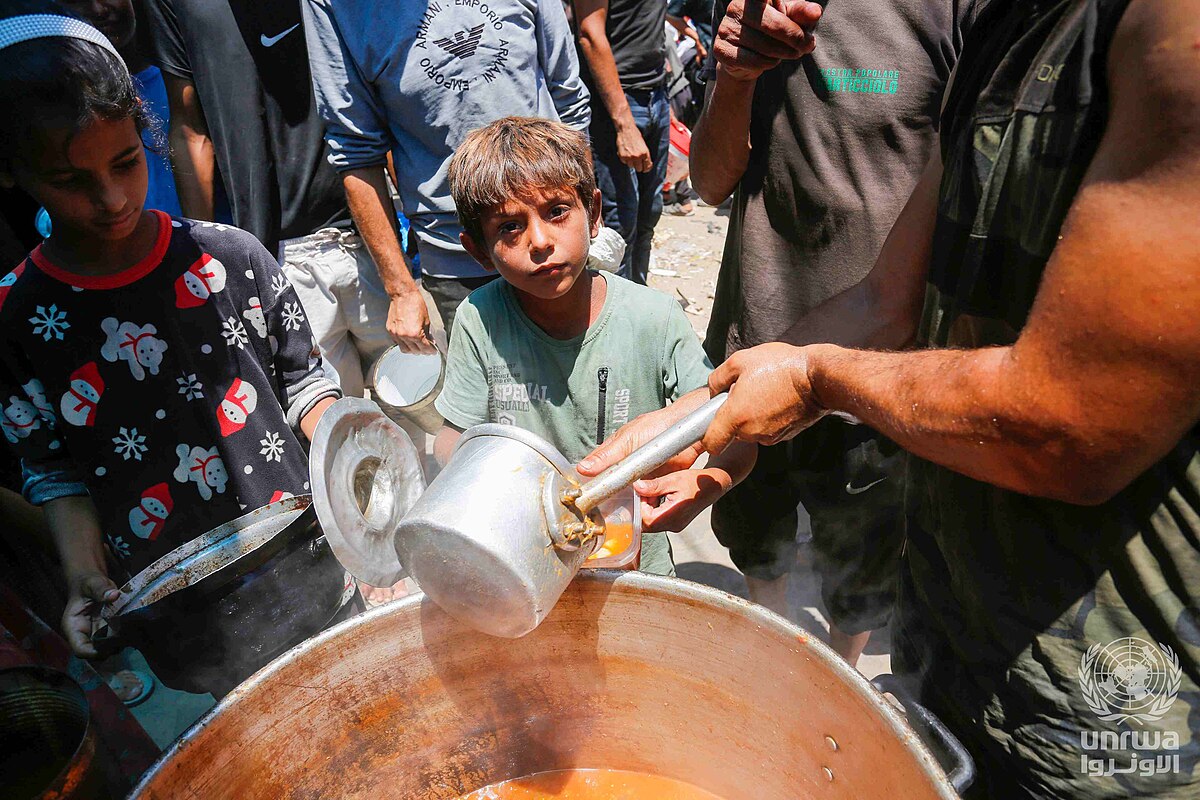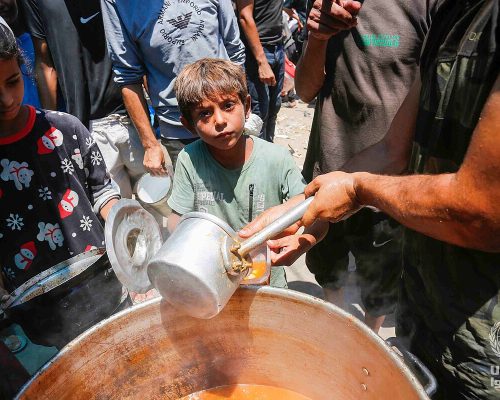Table of Contents
In a war-zone like Gaza, where cries for food & shelter many times go unheard under the breathtaking sounds of drones and missiles, the latest airdrop of Gaza starvation humanitarian assistance and aid by Israel—alongside with six other nations—has raised more questions than just an answer. At the core of the issue is a humanitarian tragedy unanswered in real time: people, especially children, are dying of starvation and malnourishment, while political battles hide over the basic human survival needs.
Under increasing international inspection and growing concerns of deprivation, Israel has announced the opening of humanitarian corridors to let in the aid convoys into the Gaza Strip. The move comes after days of very limited aid to access and increasing warnings from global organizations about a developing hunger crisis affecting the region’s two million residents.
In a statement released on Sunday, by the Israel Defense Forces (IDF) unveiled plans for a “localized tactical pause” in military operations in three areas of Gaza—Al Mawasi, Deir al-Balah, and parts of Gaza City. The daily pauses will reportedly occur from 10:00 AM to 8:00 PM local time and are aimed at helping the safe distribution of humanitarian aid.
Additionally, the IDF confirmed that they had airdropped several aid packages into Gaza, containing essential supplies like flour, sugar, canned goods and may more. The delivery was coordinated with international humanitarian agencies and overseen by COGAT, the Israeli military body that manages aid logistics.
🇮🇱🤝🇨🇾 SUPPORT BEYOND BORDERS: The IAF completed an airdrop operation of 32 fire suppressant payloads in order to extinguish wildfires in Cyprus.
— Israel Defense Forces (@IDF) July 25, 2025
The aircraft used are the only ones in the world with operational capability to carry out firefighting airdrops at night and in… pic.twitter.com/PSSfKz6XA2
Despite these developments, Palestinian authorities have not issued any formal response to Israel’s announcement or the airdrop operation. Meanwhile, According to Gaza’s Hamas-run health ministry (via AP News), six new deaths due to malnutrition were reported, bringing the total to 133.
The humanitarian corridors will operate daily from 6:00 AM to 11:00 PM local time, offering a window for aid organizations—including the United Nations—to deliver food and medical supplies across the enclave. However, Israel has firmly denied accusations of purposely restricting food access, calling such false claims.
WHO Director-General Tedros Adhanom Ghebreyesus described the Gaza situation as a “man-made mass starvation,” according to Reuters.
Gaza Starvation : A Humanitarian Breakdown
Israel Denies Gaza Starvation, But Reality Disagrees
The Israeli government has repeatedly denied the claims of starvation in Gaza, calling such reports as an enlarged or politically motivated. According to the Israeli spokespeople, the aid is being sent in, and Hamas is to be blamed for an obstruction in distribution. But according to humanitarian groups, including the United Nations, Red Crescent, and Human Rights Watch, sees picture differently —where in aid convoys are routinely are blocked by the Israeli-controlled land crossings, and leaving only airdrops as an option alone which is itself insufficient to meet the needs of handful population of over 2 million people.
“Where’s the aid?”
— Israel Defense Forces (@IDF) July 29, 2025
🎥 Footage from just 4 days ago shows Hamas terrorists looting an aid truck, this is the same organization spreading false claims about a deliberate starvation campaign in Gaza. Make it make sense. pic.twitter.com/lG0tRLIltS
How Is the Airdrop Happening in Gaza Starvation?
In response of growing Gaze starvation international disgrace, Israel decided to coordinate with air aid drops with six countries including the USA, Jordan, France, the UAE, Egypt, and the UK. Planes are flying over Gaza and parachute are being used to drop packages of food, water, and medicine. While this seems like noble efforts are being made but from the eyes of experts highlighted that airdrops are ineffective at scale. Large quantity of the aid lands in some random locations, where sometimes it is inaccessible to civilians, and often seized by militant groups or by chaotic crowds.
Land Route Blockade: The Real Obstacle in Gaza Starvation
The elephant in the room is the Israeli by blocking the routes on Gaza’s land crossings. Amid Aid organizations have consistently maintained that the most efficient and humane way to deliver aid is via road transport, which allows targeted, large-scale delivery. But Israel claims that allowing unmonitored aid may help Hamas, yet the result is a slow starvation of civilians, who have no role in the conflict.
It’s not famine. It’s forced starvation.
— Mohamad Safa (@mhdksafa) July 27, 2025
Mass starvation stalks Gaza as deaths from hunger rise. pic.twitter.com/zllQd0cxo8
Gaza Starvation Mounting International Pressure: Europe Speaks Up
The Gaza starvation humanitarian crisis, matching with Israel’s refusal to open land routes, has activated backlash even from European allies. French President Mr. Emmanuel recently stated (as reported by BBC) that France is reconsidering its position in recognizing of Palestine as a state, calling Israel’s military strategy “disproportionate and destabilizing.”
Furthermore, countries like the Netherlands have also raised its concern and reportedly listed Israel as a potential threat to European security, a diplomatic move that signals clearly diminishing Western support for Israel’s war strategy.
India's Stance in Gaza Starvation
India has historically maintained strong diplomatic, defense, and technological ties with Israel, making it one of India’s key strategic partners. However, India also values its long-standing support for the Palestinian cause, which is rooted in its non-aligned foreign policy principles and its colonial past.
At the United Nations, India has chosen a balanced stance—it strongly supports a two-state solution, which means recognizing the right of both Israel and Palestine to exist peacefully as independent nations. This reflects India’s commitment to peace and diplomacy.
While India condemns all forms of terrorism (including attacks by Hamas or other groups), it has also voiced concern over the rising civilian casualties in Gaza and called for uninterrupted humanitarian aid to reach affected people. This balanced approach signals India’s growing discomfort with how Israel is conducting the war, especially when it leads to large-scale suffering of innocent civilians.
In short, India is walking a diplomatic tightrope—maintaining ties with Israel, but also not turning a blind eye to the humanitarian crisis unfolding in Gaza.
Gaza Starvation: The Hostage Dilemma: Ceasefire in Exchange?
Israel`s stance in this is clear by demanded the return of their 50 hostages which they believed to be held by Hamas since the October 7, 2023 attacks. According to the Israeli sources, 30 of these hostages may have already been killed by Hamas. But on the other hand, Hamas stated that they will only release the remaining hostages, if Israel agrees to a complete ceasefire.
Is Gaza starvation Larger War on the Horizon?
If we look closely we can make it out that increasing fears, that the end of this phase of conflict will only marks it way by beginning of something worse. Should Israel get its hostages back and resume full-scale military operations in Gaza, experts believe this will trigger a chain reaction:
- Israel escalates attacks on Gaza
- Iran retaliates, possibly through proxies in Lebanon or Syria
- The U.S. steps in, backing Israel militarily
Gaza starvation Moral Question in the 21st Century
As the world witness Gaza starvation descend into deeper chaos, the fundamental question we all must ask is:
Do we want a war in the 21st century where thousands die—not from bullets—but from hunger?
In an age where in global food production is abundant, and drones can deliver aid within minutes, the fact that children are dying from lack of milk or bread is not a military failure. It is a moral one.
Conclusion: Beyond Politics, A Call for Humanity for Gaza Starvation
The crisis in Gaza Starvation is not only limit itself about geopolitics, territorial disputes, or hostage negotiations. But is more about human lives which are on stake of being lost in starvation in front of the world’s eyes. Airdrops may make headlines, but in a deep down they won’t sustain peace. The international community should go beyond statements and take real steps to ensure aid reaches those in need—through land, air, or diplomacy.
Because in the end, wars may be political, but starvation is always personal.
Why Red Sea a War zone in 2025 Explained Simply.
The GeoLens – Indian Defence & Global Affairs

Pratik Kondawale
Strategist
|| India || Defence || Global Affairs||
Founder of GeoLens.in, Pratik writes in-depth analysis on India’s defence strategy, military tech, and global power shifts delivering sharp insights through an Indian lens.


1 thought on “Gaza Starvation Crisis 2025: Humanitarian Aid or Political Optics?”